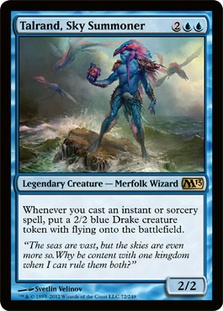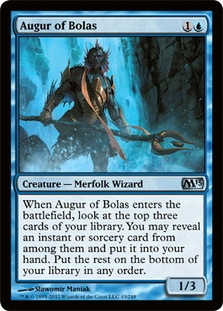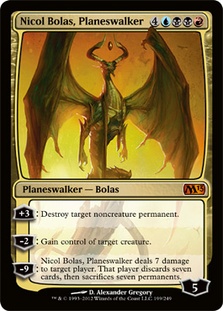Last week, in preparation for the Legacy Grand Prix in Atlanta, I did some testing with the three decks that I found to be the “best” decks in Legacy. Regardless of what criteria you use, the three decks in question are the most powerful at what they do. Those decks are:
RUG Delver, which won the Grand Prix.
Maverick, which placed in the Top 8 in the hands of PT champion Ben Stark.
Reanimator, which most of the “pro” players played (as well as myself).
While we all thought that Reanimator was the most powerful strategy at our disposal, we declined to take into consideration just how potent the backlash would be as far as hate was concerned. If you thought Gilded Drakes and Surgical Extractions were bad, try facing off against people playing maindeck Relic of Progenitus!
Sure, some of the hate cards are easier to beat than others, but that doesn’t mean that it is actually easy or that you will win every time. I began the tournament with the full set of three byes and proceeded to win my first five matches in a row, falling only in the final round of Day 1 to Alex Hon playing RUG Delver. On the turn before I put Griselbrand into play, Alex drew his Scavenging Ooze to neuter half of my deck. I died shortly after.
Day 2 was another story entirely. I won nearly every game 1 during the tournament, losing to hate cards in the second and third games and putting up a pathetic 1-5 record when it mattered the most. I failed to cash, and today we’re going to figure out why that happened and how you can avoid making the same mistakes I did.
When people talk about metagaming, they are usually referring to how they alter their decks into an abnormal state in order to combat specific archetypes or cards that they would normally have trouble beating. In the last few weeks, Griselbrand decks have been the “bad guy,” and people are changing their decks in order to contain the menace. The fact that there were zero Griselbrand decks in the Top 8 of the Atlanta Grand Prix helps solidify this argument for me, though I feel as if it will also justify the argument that Griselbrand really isn’t “that good.”
The decks I faced at Grand Prix Atlanta ranged wildly in archetypes, but one thing remained clear: none of them wanted to lose to a graveyard-based deck after sideboarding. I think that where this really hit home the most for me was when I cast Show and Tell to put Elesh Norn into play against Elves, and he dropped Humility. When Elves plays Humility after board, then you know something is definitely wrong or skewed at the very least.
The thing to remember about Legacy is that a lot of archetypes share powerful strategies, though they will often implement them in different ways. These different archetypes occasionally fall prey to the same select hate cards that are popular since people tend to fill their sideboards with “catchall” cards. This is why something like Humility is good out of a lot of decks, because so many combo decks in Legacy are based around creatures that have outrageous abilities. With that in mind, anyone who wants to play Humility can, and it will be effective in a lot of matchups.
When trying to decipher this information, we need to pay close attention and learn to apply that knowledge in the future. Over the last few weeks, Griselbrand decks have been incredibly powerful, but other archetypes were catching up. This past weekend was a tipping point where I can honestly say that Griselbrand decks were not where I wanted to be, but all that is in hindsight. What I should have realized is that the hate had caught up to Griselbrand decks, and I should have been trying to attack from a different angle.
When someone tells me that a deck is being “hated out” when it is clearly the best deck in the format, I often chalk that up to them not being good enough to beat the particular hate cards that people are throwing at them. This is generally true in Standard, as the “hate” cards tend to be a bit underwhelming. However, that is a different story altogether in Legacy. When everyone wants you gone, you disappear. When people start playing things like Warmth and Circle of Protection: Red, your red deck just can’t deal with it. While this isn’t always true with graveyard hate since most graveyard based decks can play discard or other ways to protect themselves, there is a point where the hate becomes too much to overcome. Dredge decks crops up every now and then and win a tournament because people forget that graveyard based decks exist. The same can be said for Reanimator. However, when people want to beat you, they usually can.
I generally try to stick to the rule that, if your deck has a major vulnerability, only play it if no one is really expecting it. Even the weakest players in the room can figure out that they need to side in Leyline of the Void against graveyard decks. When you’re playing Enemy #1, most of them can read an article every single day on how to beat you. That isn’t a good thing! For the most part, the best deck in a given format is the best deck for a reason. It is either the most powerful, most consistent, or most synergistic. While it is often easy to tell what the best deck is in a given format, that deck can change from week to week just depending on what everyone else around you is playing. Don’t fall victim to the easily exploitable weaknesses of your own deck! When all of these stipulations converge, you should likely find a new deck to play.
All of these reasons are why I should have picked any deck except Reanimator, but I just thought that my mediocre performance with it in the SCG Invitational was due to my own inexperience. After playing the deck more, I began to see the bigger picture and better plays, but I was definitely unprepared to deal with the abnormal amount of hate being thrown at me. Overall, I think that Maverick would have been the better choice for me personally, but I do think that playing the deck you know best is better than picking up the best deck and running with it.
…
By now, the entire spoiler for M13 has been released, and the Prerelease is happening this weekend at your local store. I would highly recommend you attend as M13 looking like it is going to be an awesome core set, which I don’t say too often. Generally speaking, core sets are full of reprints that are fairly generic and don’t leave much to the imagination. Sure, some reprints shake up Standard, but they’re rarely difficult to obtain (such as Mana Leak or Ponder). Since the spoilers began to crop up for M13, I felt like something was different. I felt like they were actually trying to make me buy the set, and that isn’t something I feel too often coming from a core set.
These are just a few of the cards that I am very excited to see in Standard, with the latter being the one that I want to talk about today. Gerry Thompson and Brad Nelson recently recorded some videos with a Mono-Blue Wizards deck that can be found here.
While Brad constantly rails me for riding his coat tails when it comes to decks, I do it more out of respect than anything else. Gerry and Brad are great deckbuilders with awesome ideas, and I just try to take their ideas and run with them. It isn’t always perfect and it is rarely pretty, but I am not here to do all the work for you. We are not here to do all the work for you. We are here to provide inspiration in an attempt to create something new and wonderful.
So, in honor of that, we’re going to get a little creative. Instead of just copy/paste on Brad’s deck and how it can be improved, we’re going to spice it up a bit. Presenting:
Creatures (15)
Lands (20)
Spells (25)

While this deck is definitely a rough draft, I would like to think that it has a lot of potential. With all of the “free” spells from New Phyrexia, it won’t be long until people figure out just how good Talrand really is. His ability can quickly overrun any creature-based matchup, and I feel like it will be very difficult for decks lacking sweepers to beat him. Unfortunately, with the nature of the deck, it is usually in your best interest to cast your cantrip spells in the early game, which could lead to some mediocre turns with Talrand, but finding that delicate balance could be what ends up breaking him.
With that said, this deck has a lot of obvious similarities to Brad’s deck. They’re both Delver-based Snapcaster decks with a ton of instants and sorceries, but what else is new? That deck has been around for quite some time now, but Talrand could give it something that it hasn’t had before: a late game. With so many cheap or free spells at your disposal, all you need to do is stabilize with Talrand, protect him just a bit, and you should be golden. Even if they deal with him, you will often be left with a 2/2 flier for your trouble.
After having watched the deck in action from the videos, I’m very excited to get some games in with this version of the deck. I feel like adding red to the deck gives you a lot of leverage against the other aggressive decks, since cards like Bonfire of the Damned and Pillar of Flame are very powerful against them. Grim Lavamancer is just icing on the cake and a card that I have longed to play with in a Standard deck for a while. I generally find a slot for him every now and then, but I think this will be a deck where he really stands out.
A creature that I’m skeptical of, but still willing to try out in the future, is Augur of Bolas. While he will almost always hit a spell when he comes down, I’m not sure he’s better than, say, Invisible Stalker. I would love to try out a “turbo” version of this deck that plays the full set of Runechanter’s Pike and Thought Scours as well as Talrand. I just don’t think that a 1/3 body is good enough to justify the slot. While you could make the argument that Invisible Stalker is just a 1/1, there is a fundamental difference between the cards and how they interact with the opponent.
As with every new deck, working out the kinks will take some time and effort. As I get to play with M13 a bit more, we’ll see if there are any other new additions that I’d want to make to the deck, and I’ll try to update next week when I have more data under my belt. Overall, I feel like Delver is where you want to be at in Standard regardless of how you feel about the card or the deck. It is just a powerful tool that you can exploit in deckbuilding and your opponent’s inability to handle it. However, I could easily see the same argument that I made about Legacy coming true for Standard. When everyone is playing Crushing Vines, your deck becomes much worse!
Over the next few weeks, I’ll be traveling a bit to some upcoming tournaments and playing in some PTQs. Hopefully I’ll pick up an envelope for Seattle as I’m confident in myself and my chances. Standard looks to be shaping up quite nicely, and I’d love to see some sweet build featuring our newest overlord:
Thanks for reading.
Todd
strong sad on Magic Online
@strong_sad on Twitter; follow me!



